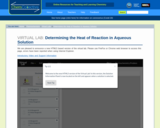
In this activity, students perform an experiment to determine the heat of a reaction.
- Subject:
- Chemistry
- Physical Science
- Material Type:
- Activity/Lab
- Provider:
- Carnegie Mellon University
- Provider Set:
- The ChemCollective
- Date Added:
- 02/05/2021

In this activity, students perform an experiment to determine the heat of a reaction.

The Developmental and Reproductive Toxicology and Environmental Teratology Information Center (DART/ ETIC) Database is made available by the National Library of Medicine's Toxicology Data Network. The database contains over 100,000 current and earlier literature citations covering teratology and other aspects of developmental and reproductive toxicology. Users may search the database by subject, title words, chemical name, Chemical Abstracts Service Registry Number, and author. The Web site also includes a useful help page and sample record for familiarizing oneself with the database.

An expert describes the carbon composition of diamonds, as well as the conditions necessary for diamond formation in this video segment from Nature.

This Nature video offers an introduction to the socio-economic value of diamonds.
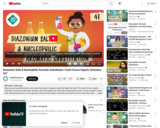
Have you ever wondered where cured meats like salami or pepperoni get their bright red color? Of course its from organic chemistry! A chemical called nitric acid gives them that bright color, while also increasing their shelf. It's also involved in some other interesting reactions. In this episode of Crash Course Organic Chemistry we'll see how nitrous acid reacts with primary amines to form diazonium salts, we'll learn about alkyldiazonium salts and aryldiazonium salts, and see what conditions are necessary for nucleophilic aromatic substitutions.

Going out in the sun can work wonders for your mood, but unfortunately too much UV exposure can do serious damage to your DNA. This damage occurs through a type of organic reaction called a pericyclic reaction. In this episode of Crash Course Organic Chemistry, we’ll explore pericyclic reactions to see how the sun can both give us life, and hurt us, and also look at other important pericyclic reactions, such as the Diels-Alder reaction.

Learn about how particles move from an area of greater concentration to an area of lesser concentration through the process of diffusion.
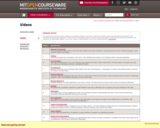
Descripción del curso:
El "Manual de técnicas de laboratorio digital" desarrollado por el MIT, es una serie de videos diseñados para ayudar al alumno a prepararse para sus prácticas de laboratorio de Química Orgánica. Cada video proporciona una demostración detallada de una técnica de laboratorio, así como información y consejos útiles. Estos videos están pensados para complementar, y no reemplazar, el manual de laboratorio del alumno y los guiones de prácticas. De hecho, se beneficiará más de ver los videos si ya ha leído sus guiones.

The “Digital Lab Techniques Manual” is a series of videos designed to help you prepare for your chemistry laboratory class. Each video provides a detailed demonstration of a common laboratory technique, as well as helpful tips and information. These videos are meant to supplement, and not replace, your lab manual and assigned reading. In fact, you will most benefit from watching the videos if you have already read the appropriate background information. To be a great experimentalist, you must understand both theory and technique! If you have questions about what you see, make sure to ask your TA or your instructor.
WARNING NOTICE:
The experiments described in these materials are potentially hazardous and require a high level of safety training, special facilities and equipment, and supervision by appropriate individuals. You bear the sole responsibility, liability, and risk for the implementation of such safety procedures and measures. MIT shall have no responsibility, liability, or risk for the content or implementation of any of the material presented. Legal Notice

A sequence of teaching units and activities with the aim of acquiring a series of specific skills about waste management (in particular about Home compost/Food waste).This is the third Digital Project of a set of 6 facing specific challenges about waste management for primary and secondary education

The purpose of this week's lab is to
- prepare calibration standards
- use a UV-Vis spectrometer to determine the spectral peaks for several dye solutions, and create a calibration curve
- calculate how much of each single-element standard solution is needed to make a multi-element stock solution
(Note: this resource was added to OER Commons as part of a batch upload of over 2,200 records. If you notice an issue with the quality of the metadata, please let us know by using the 'report' button and we will flag it for consideration.)

Units... some may say they are usless. However units are very important and fundementally they provide meaning to numbers. So since you are learning chemistry and chemist love units you may just want to jump on the unit train. This module will go over one of the most effective tools to converting units, dimensional analysis.At the end of the module you should be able to...Convert between unit perfixes.Utilize dimensional anlysis to convert between two units. Corresponding OpenStax Textbook Section 1.6Dimensional Analysis

This course introduces principles and technologies for converting heat into electricity via solid-state devices. The first part of the course discusses thermoelectric energy conversion and thermoelectric materials, thermionic energy conversion, and photovoltaics. The second part of the course discusses solar thermal technologies. Various solar heat collection systems will be reviewed, followed by an introduction to the principles of solar thermophotovoltaics and solar thermoelectrics. Spectral control techniques, which are critical for solar thermal systems, will be discussed.
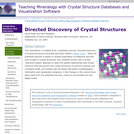
This contribution is modified from a published exercise "Directed Discovery of Crystal Structures Using Ball-and-Stick Models" [Mogk, 1997] . While the published exercise is based on student exploration of traditional ball-and-stick models of crystal structures, this modified version uses a similar "discovery-based" approach to teach the spatial relationships and crystal-chemical rules that govern the crystal structures of common minerals and crystalline solids, but instead uses the latest web-based crystallographic information and visualization programs. A few changes in the content have been made from the published exercise, mainly to accomodate the new digital media.
(Note: this resource was added to OER Commons as part of a batch upload of over 2,200 records. If you notice an issue with the quality of the metadata, please let us know by using the 'report' button and we will flag it for consideration.)
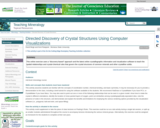
This contribution is modified from a published exercise "Directed Discovery of Crystal Structures Using Ball-and-Stick Models" [Mogk, 1997] . While the published exercise is based on student exploration of traditional ball-and-stick models of crystal structures, this modified version uses a similar "discovery-based" approach and the latest online crystallographic information and visualization software to teach the spatial relationships and crystal-chemical rules that govern the crystal structures of common minerals and crystalline solids. A few changes in the content have been made from the published exercise, mainly to accommodate the new digital media.
(Note: this resource was added to OER Commons as part of a batch upload of over 2,200 records. If you notice an issue with the quality of the metadata, please let us know by using the 'report' button and we will flag it for consideration.)
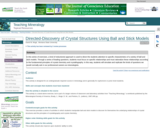
In this series of exercises, a kind of reductionist approach is used to direct the students attention to specific characteristics of a variety of ball and stick models. Through a series of leading questions, students must focus on specific relationships and must rationalize these relationships according to the fundamental principles of crystal chemistry and crystallography. In this way, students will simulate and replicate the kinds of questions we would normally ask in our professional careers as mineralogists. This approach also addresses other major recommendations from Project 2061: start with questions about nature, and concentrate on the collection and use of evidence. Other questions ask students to make connections to basic chemistry (e.g. bond types, relative strength of bonds, bond angles), determinative mineralogy (most likely place to develop cleavage), analytical techniques (e.g. preferred orientations for X-ray analysis), and so on. The final reflection questions will allow students to "discover" Pauling's Rules, a much more effective learning strategy than simple memorization of these rules (commonly with little or no understanding on the part of the students).
(Note: this resource was added to OER Commons as part of a batch upload of over 2,200 records. If you notice an issue with the quality of the metadata, please let us know by using the 'report' button and we will flag it for consideration.)

In this activity, students investigate different methods (aeration and filtering) for removing pollutants from water. They will design and build their own water filters.
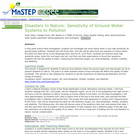
This activity is a field investigation where students will observe three areas with high sensitivity to pollution, and test water quality in two of the locations.

Students demonstrate the erythrocyte sedimentation rate test (ESR test) using a blood model composed of tomato juice, petroleum jelly and olive oil. They simulate different disease conditions, including rheumatoid arthritis, anemia, leukocytosis and sickle-cell anemia, by making appropriate variations in the particle as well as in the fluid matrix. Students measure the ESR for each sample blood model, correlate the ESR values with disease conditions and confirm that diseases alter blood composition and properties. During the activity, students learn that when non-coagulated blood is let to stand in a tube, the red blood cells separate and fall to the bottom of the tube, resulting in a sediment and a clear liquid called serum. The height in millimeters of the clear liquid on top of the sediment in a time period of one hour is taken as the sedimentation rate. If a disease is present, this ESR value deviates from the normal, disease-free value. Different diseases cause different ESR values because blood composition and properties, such as density and viscosity, are altered differently by different diseases. Thus, the ESR test serves as a real-world diagnostic screening test to identify indications of the presence of any diseases in people.
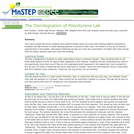
This lab activity shows students the Law of Conservation of Matter and intermolecular forces by having them dissolve packing peanuts in acetone.